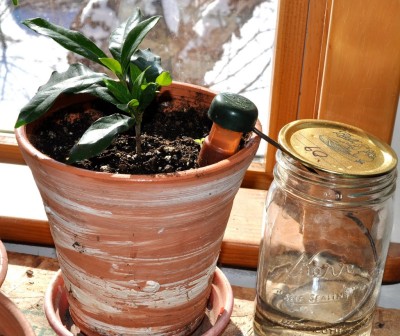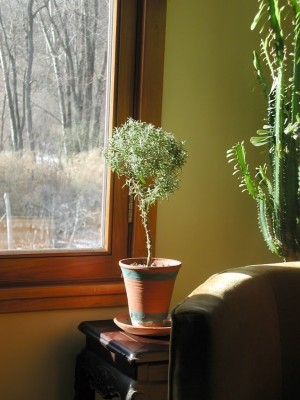(rosemary and gardenia failures)
A reader, in telling me how much he enjoyed reading this “gardener’s notebook,” went on to say that he especially liked – perhaps he said “found interesting” – my failures. Well, here you are Alan: Looks like I’ve done in another rosemary plant. I went to water it and was presented with leaves that were a bit more needle-like than normal rosemary leaves, and drier. I soon realized I’d killed another rosemary plant.
Except for periodically dying, rosemaries generally have been ideal herbal houseplants for me. Each leaf packs a lot of flavor, so it’s a plant you can actually use freely in cooking without decimating it. It’s also decorative as well as culinary, whether grown as a sprawling bush or — my choice – as a miniature tree. And it tolerates the dry, low-light conditions of heated homes in winter.

This last point, I think, has been responsible for my “rosemary death syndrome.” Those narrow, waxy leaves tolerate dry air, but the plant as a whole, my guess, needs plenty of water. Rosemary is not difficult to root from cuttings, so I’ve always had plenty of new plants to replace those I lost; my tack with current replacements is to make sure the soil in their pots is constantly moist. Already I’m amazed at how thirsty these plants really are.
__________________________________
Gardenias are not as easy to root from cuttings as are rosemary plants, so the gardenia I lost a couple of months ago did not have a replacement waiting in the wings. Nonetheless, I’m taking up the challenge and am determined to grow gardenia successfully.
The more I mull over that loss, the more I believe water – or lack of water – was also the problem with the gardenia. As a matter of fact, too much water or too little water is probably the most common problem with growing plants generally. One of the challenges in growing gardenia is that it is particularly sensitive to either excess or insufficient water; I believe I erred in the direction of insufficiency.
Okay, so now I have purchased a new gardenia, a small plant in a 3” pot. My plan is to add some extra peat moss (to hold moisture) and some extra perlite (to drain off excess water) to the potting soil for this plant. I also plan to water more frequently – that perlite will help any excess water run down and out of the pot.

And then, just to make sure the plant doesn’t dry out, I’m going to hook up an automatic, capillary watering contraption that’s been sitting on a shelf in my garage for years. This contraption is basically a porous, hollow spike, the pointed end of which gets pushed into the soil while its opposite, open end fits to a plastic tube the end of which sits in a jar of water. As the soil dries out, it sucks moisture out of the porous spike which, in turn, draws it in from the reservoir via the plastic tube. The whole setup isn’t particularly attractive, but I’m growing gardenia mostly for the fragrance of its blossoms, which can make you giddy whether they’re on the plant or floating in a bowl of water.
———————————————————
That dead gardenia did present an opportunity for another visit to Logee’s Greenhouses in Danielson, Connecticut. Why go all the way to Logee’s to replace a relatively common plant like a gardenia? Because they offer about a dozen varieties of gardenia, as well as quite a few jasmine varieties, oodles of begonias, and all sorts of other exotic and wondrous houseplants.
I opted for “Four Seasons” gardenia, which is said to bloom sporadically throughout the year. Each blossom packs a whollop of aroma so a constant supply of just a few blossoms is all I need.





Some varieties of rosemary are more suitable to wintering over indoors than others. I have never thought to root some cuttings. At least, not when the plant was still alive. My hindsight is pretty good.
Hi Lee. I have tried and tried and tried to bring rosemary through the winter inside, outside, in a cold frame, in a basement, in a window…every year.
As of yet, no success.
Hi Jane,
You didn’t say whether or not the plants you tried to overwinter were potted or dug up; I suggest starting with potted plants in well-drained soil. Then put the plant in a bright location and make sure the soil never ever gets dry.
I’ve found Gardenia cuttings root easily in a jar of water or vase. I tend to cut the stems a bit longer 5 to 8 inches when picking for arrangements in the house. I strip most of the leaves and remove the bloom when spent.